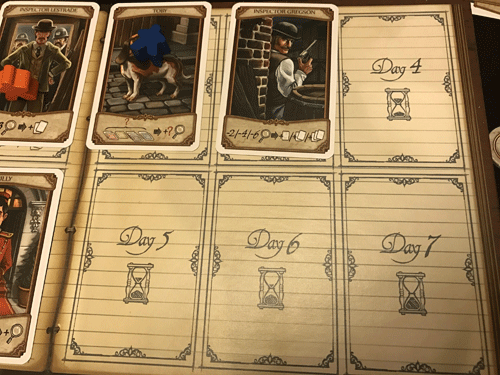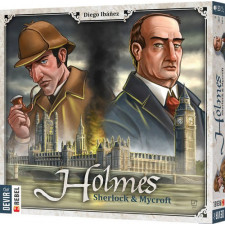Holmes: Sherlock & Mycroft Review
on Mar 15, 2017
There’s been a small rise in the popularity of a certain English detective. Sherlock Holmes is a hot commodity right now, thanks in no small part to Benedict Cumberbatch’s portrayal. I have that very BBC television show to thank for introducing me to Mycroft Holmes, a character I was wholly ignorant of. It’s the sibling rivalry of these two characters that forms the basis for Holmes: Sherlock & Mycroft; an investigation game that isn’t really about investigating. Or Sherlock and Mycroft for that matter.
Confused? It’s fine. There’s a paragraph at the beginning of the rules that tells the story of a bombing. Mycroft believes it’s an open and shut case but Sherlock was hired to clear the name of the lead suspect, Michael. The two go at it for 7 days, gathering evidence and interviewing characters from Sir Arthur Conan Doyle’s universe. At the end Michael is either convicted or acquitted based on who collected the most points but there isn’t actually a case to solve. There is no truth to discover. Holmes is a set collection game with worker placement elements where the person with the most VPs wins.

Yet despite being a game about an investigation and not a game of investigation, one of the best things about Holmes is how well it nails the theme. The spaces in which your workers are sent to work are in fact the familiar faces of the Sherlock universe. Dr. Watson is there, providing a reliable source of point scoring clues. Inspector Lestrade is also always available and capable of providing more clues than Watson; however the brothers often loathe engaging the common police of Scotland Yard. His extra clues come at a higher cost to the player.
These little homages to the setting both hide and elevate a rather workman-like game. Investigation tokens need to be gathered before converting them into evidence cards. These cards are the sets you collect to score points and are another clever little touch. Each type of clue is worth a number of points equal to the number of cards available in that set. The majority winner scores that number minus the cards collected by their opponent. If all cards in a set are collected by both players, this number is simply the number of cards collected by the set winner.
Initially, strategy seems simple: get a lot of cards. In general, this is pretty easy to do. Multiple characters are available to grab cards from the board or your opponent. It’s complicated by characters becoming unavailable under repeated use, but neither player will have a problem grabbing piles of cards. However, it’s possible to bury cards out of play preventing your opponent from ever collecting them. Clever play – and repeated trips to Porky Johnson – can see you scoring more points through denial than you claim through collection.

Navigating the timing of character availability along with the push and pull of denial vs collection really turns Holmes: Sherlock & Mycroft into a standout game. It competes admirably with other small box 2 player games like Jaipur or Patchwork while claiming its own unique space. It tweaks both worker placement and set collection just enough to make them feel fresh, without needlessly complicating either mechanic. While it won’t satisfy gamers looking to investigate a crime, it does provide a puzzle to noodle on from your chair in 221B Baker Street.

 Customer Support
Customer Support  Subscribe
Subscribe 




 Account
Account  Wishlist
Wishlist 

